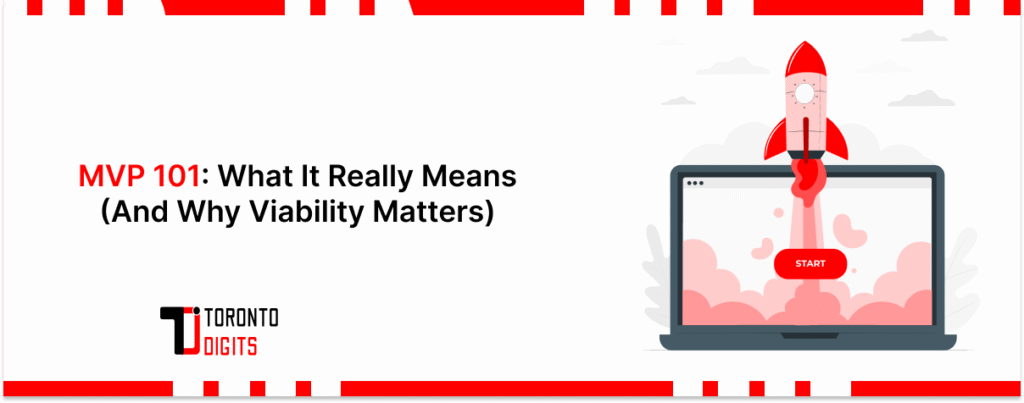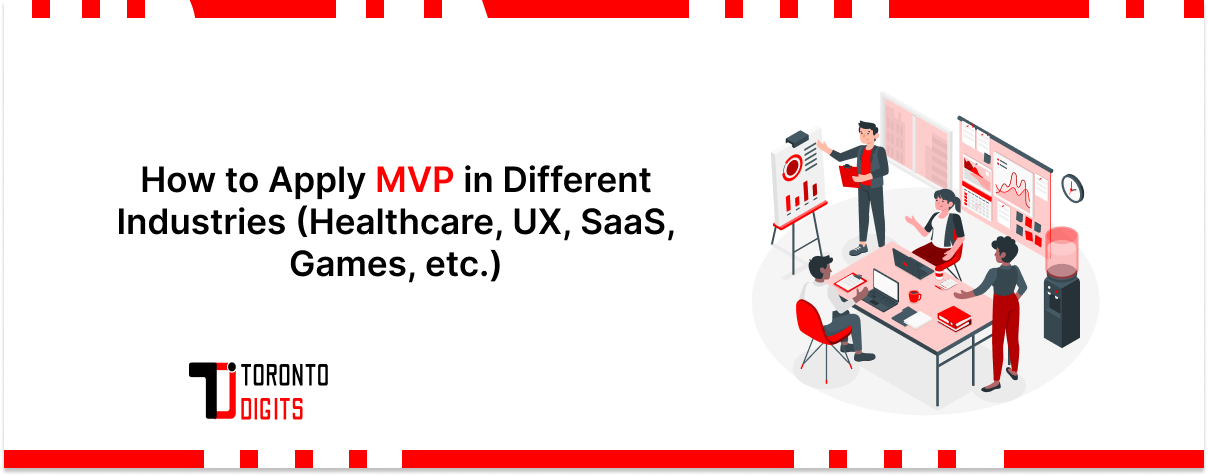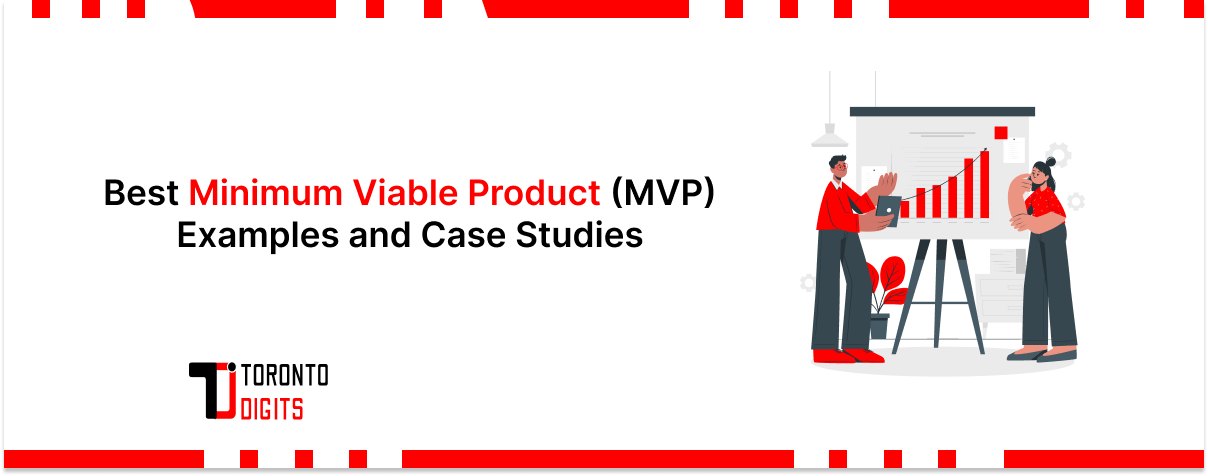Did you know Amazon began by selling used college textbooks? What’s now a global giant making billions actually started with one simple goal: helping students get books delivered to their doorstep. It’s a powerful example of how starting small—with a Minimum Viable Product—can lead to something massive.
The original definition of “Minimum Viable Product”
The term Minimum Viable Product definition was first introduced by Frank Robinson in 2001, and the formal description is as follows (emphasis mine):
“The MVP is the right-sized product for your company and your customer. It is big enough to cause adoption, satisfaction, and sales, but not so big as to be bloated and risky. Technically, it is the product with maximum ROI divided by risk.”
Put simply, a Minimum Viable Product should deliver some kind of return—whether money, user interest, or valuable feedback—while staying lean. Adding extra features shouldn’t increase cost or risk beyond the value they bring.
While this original definition of Minimum Viable Product is helpful, it’s not widely used in today’s fast-moving product world. Why? Because predicting ROI and risk before building is tough. Still, the MVP concept holds: it should feel like a real, usable product people could actually buy or engage with.
What’s a Minimum Viable Product (MVP)?
In simple terms, what is a Minimum Viable Product? It’s the most basic version of a product you can create and still release to customers. The goal is to test your idea with real users, gather feedback, and learn what works—without overspending.
Eric Ries, author of The Lean Startup, helped popularize this idea. He explains:
“The simplest version of a product that helps a team learn what customers really want, using the least amount of effort.”
So, if you’re wondering what Minimum Viable Product means, think of it as a testable, functional version of your vision—nothing more, nothing less.
Why MVPs Matter and How They Help Your Business?
MVPs are built on the lean startup philosophy, which is about learning quickly and scaling wisely. Instead of a heavy upfront investment, a Minimum Viable Product explained is a low-cost step toward validation.
The advantages of Minimum Viable Product include:
- Saving money by focusing only on essentials
- Launching faster than full products
- Building directly from real user input
- Attracting early investors with proof of traction
- Reducing risks by avoiding wasted features
These benefits of Minimum Viable Product make it an essential step for startups aiming for long-term success.
How to Build an Effective MVP
Creating your MVP can be one of the most challenging—but also the most crucial—steps in your business journey. A good MVP should solve a real problem for your target audience, help you gather useful feedback, and focus only on the must-have features.
Think of your MVP as a test run for your business idea. It’s there to help you measure what matters: how much it costs to build, how customers respond, and whether it truly delivers value, both to users and potential investors.
To shape your MVP the right way, you’ll need clear ideas, real validation from your audience, and close teamwork using an agile approach.
Here’s how to get started with building your MVP:
(You can list the steps here if you’d like me to help write or reword them, too.)
1. Pinpoint the Problem Your Customers Face
What issue are you solving for your audience? To build a great MVP, you need to step into your users’ shoes—just like Uber founders Garrett Camp and Travis Kalanick did back in 2008. Imagine you’re at a late-night conference in a busy city and struggling to find a cab, especially in bad weather. Wouldn’t it be easier if you could just tap your phone and get a ride?
That idea sparked what became Uber. But first, they talked to real people. They asked:
- Would you use an app to quickly book a ride?
- Would texting a driver feel convenient?
- How would you prefer to pay?
This kind of research helps you figure out who your users are and what they truly want from your solution.
To shape your MVP, your market research might include:
- Checking out the competition
- Running a SWOT and opportunity analysis
- Talking to users through surveys, interviews, or focus groups
Then, back up those insights with real data. This helps you clearly define your customers’ pain points and decide which features your MVP absolutely needs to deliver value. Plus, this research becomes powerful proof when you’re pitching your idea to investors.
Based on this approach, Camp and Kalanick created the first version of Uber—called “UberCab.” It worked entirely through SMS, letting people book a ride with just a text. And that simple start became the foundation of one of the world’s biggest ride-hailing apps.
2. Understand the Competition
Back in 2006, launching a cab-hailing service meant little to no competition. Fast forward to 2023, and the market is flooded with ride-sharing apps offering similar features. So, the big question is: What makes your product different?
Ask yourself:
- What are users still frustrated with?
- What do other apps fail to deliver?
- How much would customers be willing to pay to fix those issues?
To figure this out, create a pros and cons list that clearly shows how your solution stands out. Highlight what you do better, where others fall short, and how your MVP solves problems in a way no one else does.
This comparison helps you position your product more effectively—and gives you a solid edge in the market.
3. Test Your MVP to See If It Works
Once your MVP is ready, it’s time to put it to the test. Start by choosing a small group of testers—this could be your internal team or a few early users. Let them try out the basic version of your product, whether it’s a simple landing page, an SMS-based system (like early Uber), or a basic single-page app.
Make sure to set clear deadlines and ask your testers to focus on two key things:
- Does it work as expected?
- Does it actually solve the problem?
Their feedback will give you valuable insight into what needs fixing, what’s working well, and how to make the product better before sharing it with a wider audience.
4. Prepare for Launch
If your MVP performs well during testing, congrats! You’re on the right track. Now it’s time to move forward with confidence.
This stage is all about fine-tuning. Keep researching, improving, and testing. Once your key features are solid and solving real problems, you can launch your MVP to early users.
From there, you’ll enter the build-measure-learn (BML) loop:
- Build based on user needs
- Measure how people use it
- Learn what to improve next
It’s the beginning of turning your MVP into a full-fledged product that people love.
What Are Some Real-World Examples of MVPs?
An MVP isn’t just a rough draft or a one-time test—it’s often the foundation of world-changing companies. Many successful businesses started with simple MVPs to test ideas, learn from users, and grow into what they are today. Here are a few powerful examples:
Amazon
Before it became the go-to for everything from electronics to groceries, Amazon was just an online bookstore. Jeff Bezos launched it from his garage, selling only books to test the demand for e-commerce. That simple MVP gave him the insights needed to scale into the tech giant we know today.
Uber
Uber didn’t start as the polished app you use now. It began as UberCab, a basic SMS-based service that let San Francisco users request a ride with just a text. Testing in one city allowed the team to gather real feedback and build what would become a worldwide ridesharing platform.
Spotify
Before becoming the world’s leading music streaming service, Spotify launched with a minimal version of its product for beta users. Their MVP focused entirely on one thing—smooth, fast playback. Once users loved it, they scaled up with confidence.
Airbnb
Airbnb’s first MVP? The founders were renting out air mattresses in their own living room during a conference in San Francisco. They built a basic site to list the space and gauge interest. That tiny experiment evolved into the global hospitality marketplace we see today.
Netflix
Netflix started with a simple DVD rental website. Users could order movies online and get them delivered by mail. Its MVP focused on convenience, using subscriptions and a queue system that paved the way for the eventual streaming service.
Zappos
Zappos validated its online shoe-selling concept by taking photos of shoes from local stores and posting them online. When someone placed an order, they’d go buy the shoes themselves and ship them. This low-risk MVP helped prove that people would buy shoes online.
Dropbox
Rather than build the full product, Dropbox launched with just a demo video. It showed how the tool worked and what it could do. That video generated so much interest that it validated the concept before a single line of backend code was finalized.
Groupon
Groupon launched in just one city, offering daily deals and coupons to local businesses. Once they saw demand, they expanded city by city and eventually added more service categories.
Facebook’s MVP was limited to students at Harvard. This allowed the team to focus on a small, engaged user base and refine the experience before opening it up to the world.
Before Reels, stories, and videos, Instagram was simply a photo-sharing app with a few filters. Its minimal feature set helped it gain traction quickly and grow based on real user behavior.
Duolingo
Duolingo launched as a free language-learning app that made learning feel like a game. Its MVP focused entirely on value and user experience—something that still defines the platform today.
TikTok (formerly Musical.ly)
TikTok began as Musical.ly, which offered 15-second lip-sync videos. It tested users’ interest in short-form video creation and consumption—something that quickly exploded into a global trend.
Loom
Loom’s MVP was built for teams that needed expert video feedback. It allowed users to record and share screen-based video messages easily—an idea that filled a clear workplace gap.
iPhone
Apple’s first iPhone didn’t include the App Store, copy/paste features, or even MMS. But it introduced the world to a touchscreen mobile device, proving the concept before adding more features later.
Aardvark
Aardvark’s MVP was a people-powered Q&A search engine. Instead of using algorithms, it lets real people answer questions, offering a fresh, human twist on traditional search.
The Key Takeaway?
All of these companies used MVPs not just to test their product ideas, but to actively learn, pivot, and grow based on real customer feedback. Whether it’s a demo video, a basic webpage, or even renting out a couch, starting small often leads to something big.
Evolving Beyond the MVP
Launching an MVP is just the beginning. As your product grows, so should your strategy. That’s where concepts like the Minimum Lovable Product (MLP) and the Minimum Marketable Product (MMP) come in—each helping you move closer to long-term success.
What’s an MLP (Minimum Lovable Product)?
An MLP is more than just functional—it’s something your users actually love right from the start. While an MVP aims to test ideas quickly and affordably, an MLP is all about delivering real value and creating a great experience. It solves a meaningful problem in a way that feels smooth, helpful, or even delightful.
An MLP doesn’t need to reinvent the wheel. It can enter a crowded market as long as it does things better—maybe it’s easier to use, more affordable, or just more enjoyable. If your users feel connected to it emotionally or practically, you’ve nailed your MLP.
What’s an MMP (Minimum Marketable Product)?
Think of the MMP as the version of your product that’s finally ready for prime time. It’s gone beyond the prototype phase and has proven value. Now, it’s simple but strong enough to start selling.
The MMP doesn’t have to include every feature on your wishlist—just the essentials that your target market is willing to pay for. For example, Spotify started with a basic streaming demo (their MVP), refined the experience with feedback (MLP), and then rolled out the app and subscription model as their MMP.
In Short:
- MVP = Basic version to test your idea.
- MLP = Version users can love right away.
- MMP = Version that’s ready to sell.
These stages help you grow smarter, keeping both your customers and your goals in mind. Would you like a table or diagram comparing MVP, MLP, and MMP side by side?
Best Practices for Building a Strong MVP
Now that you know the key steps of MVP development, let’s simplify it even further with a few practical tips to make sure your MVP hits the mark:
- Keep it simple and user-friendly: Even if your MVP only includes the core features, it should still feel smooth and easy to use. If users find it confusing, it defeats the purpose.
- Stick to your timeline: Staying on schedule helps you avoid scope creep — that is, adding unnecessary features that slow things down and distract from the main goal.
- Don’t be afraid to experiment: MVPs are made for testing. Instead of playing it safe, try new ideas. You might discover something that sets your product apart.
Wrapping It Up
With our experience in MVP development, we know how powerful a Minimum Viable Product can be in testing new ideas and validating markets. The Minimum Viable Product synonym might change (prototype, pilot, etc.), but the core principle is the same: start small, test fast, and grow smart.
Without a clear Minimum Viable Product defined stage, businesses risk wasting resources. That’s why building the right MVP matters—it’s not just about launching, it’s about learning and scaling.
FAQs: Minimum Viable Product (MVP)
What is the meaning of Minimum Viable Product?
It’s the simplest form of your product that still delivers value and is testable with real users.
Why is Minimum Viable Product important?
Because it helps you validate ideas, save costs, and gather feedback before a full launch.
What is the purpose of a Minimum Viable Product?
To minimize risk, test demand, and learn what customers truly want.
What defines a Minimum Viable Product?
Its core features solve a problem without unnecessary extras.
What are the characteristics of a Minimum Viable Product?
- Lean and simple
- Functional and testable
- Provides measurable value
- Designed for iteration
What is MVP in simple words?
It’s a basic version of your product that you can show to users to see if the idea works.
What’s another term for Minimum Viable Product?
Some call it a “prototype,” “pilot,” or “proof of concept,” but MVP is the most widely used term.




